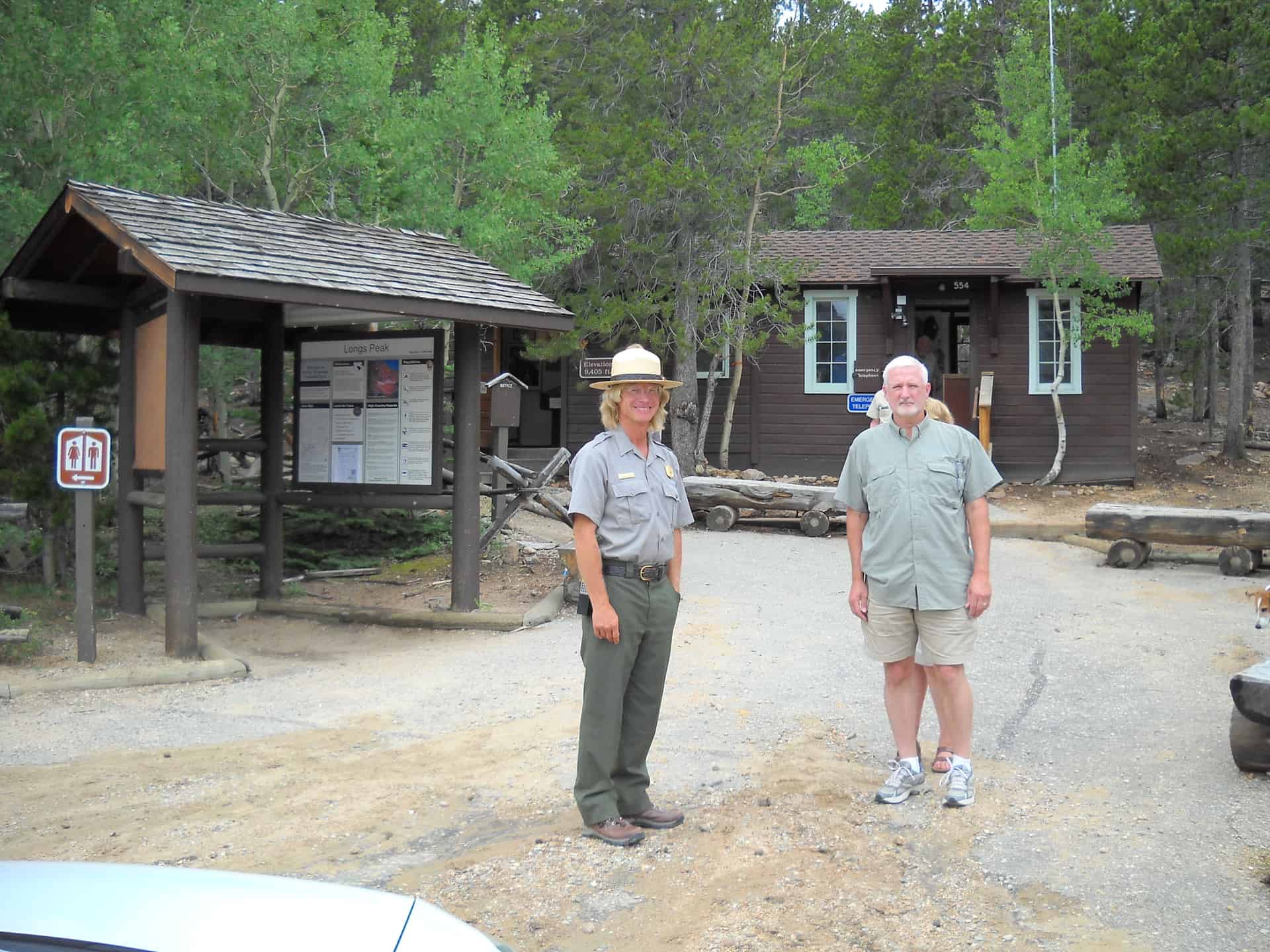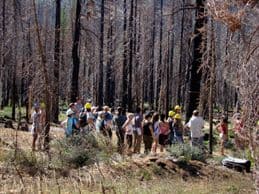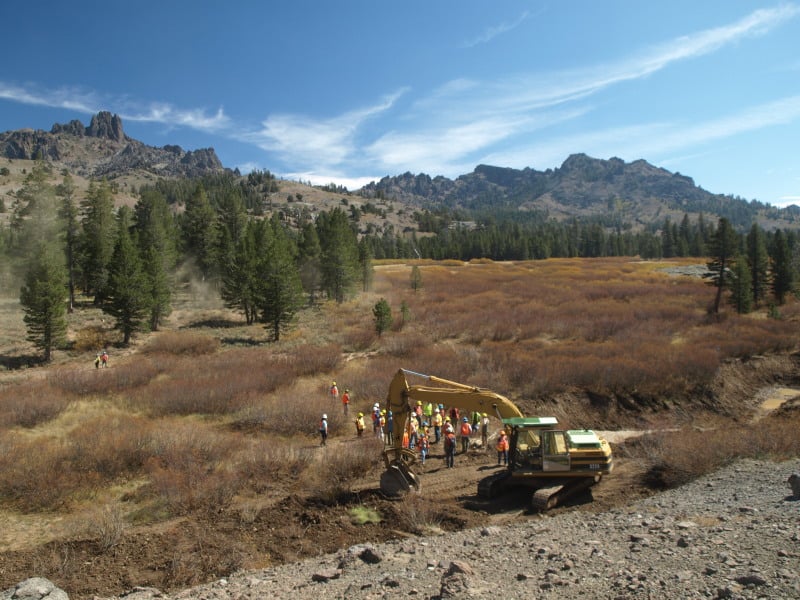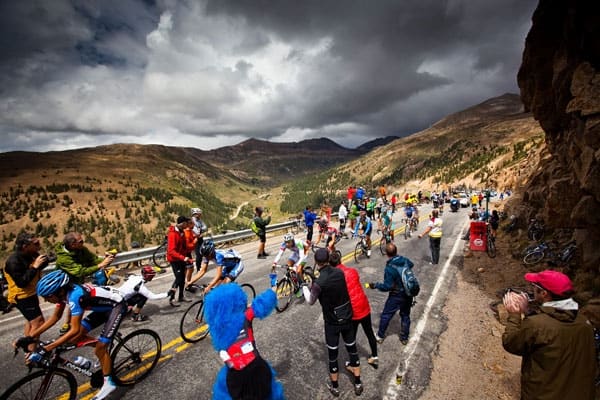
I looked for Forest Service “presence” at Brainerd that day (several years ago) and this is all I found, in not the most scenic spot..
Oh, but this is why people actually go there.. some might argue that a site this beautiful should be acquired by the Park Service, who would end up charging..it’s all very complex. So this is a fairly unique post in that I don’t know as much about this topic as I do others.. so hoping others from the recreation world can help. If you are in the Forest Service and you know something that you think would help the discussion, please do, you can make up an alias in yahoo or google if you don’t want to use your name.

Several years ago, I was intending to write a post for this blog, called “A Tale of Two Trailheads” comparing the management of Brainerd Lakes (concessionaire) and Long’s Peak (Park Service); never did, but here are the photos and the below article reminded me of it. Let’s just reflect on the two trailheads while we read the article.
The Denver Post had this article in the business section today, but I found it fairly confusing. Maybe some readers can help.
The first sentence is:
“A U.S. Forest Service push to privatize management of campgrounds is prompting a backlash from critics who oppose concessionaires charging day-use fees to access federal lands.”
Because before I retired we had the Mt. Evans case, which was about what I’ll call the “what for” question (WhatFor) “what services can you charge for?”, I thought that that was a separate question from “should concessionaires be allowed to run campgrounds?”, the concessionaire campgrounds (or ConCamp) question.
Why do we have to pay to go into public lands? The land belongs to the people, and the people should be able to use the land for free,” said 64-year-old Wimert, who began decrying day-access fees when he was charged entrance to pedal into Brainard Lake Recreation Area two years ago.
Somehow the Forest Service has lost its way. They are no longer caring for the land and serving the people. They are serving themselves,” he said.
Let’s compare Brainerd to Longs. Do we say if the Park Service charges to access Long’s, they have “lost their way” and are “serving themselves?”. No we’d probably say we are paying for the quality facilities they have there.
I don’t think the Forest Service is “serving themselves”. They didn’t have enough money to run these places, so partnerships seemed like 1) a way to provide public service 2) within the budget. Like everything, this had the unintended consequence of empowering a small vocal group to become active politically to get more goodies.
Now. one of my previous bosses would say something like “campgrounds are a chance for us to touch the public, to be there in uniform, to help members of the public be outdoors. Nothing can be more important than us to be there for them. The Park Service “gets it”, we need to “get it” also.” Even though he had a lot of passion and desire, and about as much power as someone is likely to get in the Forest Service, in my opinion, he couldn’t do anything because the bucks aren’t there (and now there is an entrenched political group supporting it). If you, as I do, think that this is important, I wish we could all work together to do something.. agitate for a separate budget line item for campgrounds, or ???
“The Forest Service is allowed under current federal law to keep all the money they bring in from a campground, so there are no efficiencies gained by contracting a private company,” she said.
In Colorado, seven national forests covering 14.5 million acres include 1,268 non-fee sites and 540 fee areas with 469 recreation sites operated by concessionaires. Nationally, half of all Forest Service camping sites — 82 percent of the reservable camping sites available under the National Recreation Reservation Service — are managed by concessionaires. Thirty years ago, the Forest Service primarily operated its own lands.
Concessionaire operations are a big money business. According to the Forest Service, a small campground concession with one to three developed sites can produce revenue ranging from $50,000 to $105,000. A larger campground with 10 to 12 sites can generate more than $1 million in annual revenue.
Total campground concessionaire revenue nationally is estimated at $35 million.
My understanding is something along the lines of “there is no money to hire someone to empty the toilets and do maintenance, and campground fees alone can’t pay for those people.”
Therefore, concessionaires seem like a good idea because it’s that or shutting them down. And of course concessionaires only want the best ones, so that leaves the Forest Service with the less popular ones that have fewer visitors. And of course, the FS has lots of rules and regulations and hiring and pay requirements, which maybe the concessionaires don’t have to follow, which I assume (???) is how they can make a profit.
The funds going back to the Forest don’t help if it’s a net loss.
The increasing use of private concessionaires is riling some users just as a national program aimed at boosting private investment in federal recreation sites gains momentum. The Washington D.C.-based American Recreation Coalition soon will unveil a dozen pilot programs — at least one of which is in Colorado — that would forge public-private partnerships allowing for-profit concessionaires to invest in upgrades like on-site storage of boats at marinas and improved facilities at campgrounds.
I think all of us really need to look at this cautiously, but this is about ConCamp, it seems like, not what the lawsuit was about which is about WhatFor. It seems to me that NEPA provides for good discussion of projects, but not so much programs like this. I wonder what sort of public involvement has been done with broader topics like the role of concessionaires?
The lawsuit argues that the Forest Service’s permitted concessionaires charge fees “even when visitors do not use any facilities or services of the area, but simply wish to enter Forest Service lands to engage in undeveloped recreation.” The lawsuit also contends that issuing special permits without public involvement to concessionaires who charge fees does not meet the federal requirement for public notice of pricing changes.
In 2009, the Forest Service proposed cutting the camping fee discount for interagency passes like the Golden Age and Senior passes from 50 percent to 10 percent, citing concessionaire concerns over lost revenue. In 2010, the agency scuttled the reduced discount proposal. Still, concessionaires don’t have to accept the passes.
The first paragraph seems to me like it’s about the WhatFor question but whether concessionaires need to follow the same rules the FS does? The second paragraph seems to be about ConCamp- I don’t see why concessionaires wouldn’t have to follow the rules. After all, following the rules is one part of why it’s expensive for the FS to run them in the first place.
Finally, Derrick Crandall is quoted as saying:
“We are trying to broaden the use of public lands,” said coalition president Derrick Crandall, pointing to stagnant visitation to Forest Service campgrounds when compared to private campgrounds. “We are looking at ways to bring these worn-out, outmoded facilities up to levels we expect at ski areas. We really see this initiative as a win-win for everyone.
Now the other thing I’ve noticed about say, parts of the Med-bow and the Bighorn, is that few people are camped at the campgrounds, but many, many people are dispersed camping throughout the forest. First, you have to pay money, second you have to follow rules, third you are right next door to your neighbors, fourth you can’t make up configurations of RV’s, horse trailers and tents that fit your friends and family. I have been on different parts of both of these forests at times when all the likely dispersed camping spots have been filled and the campground is relatively empty. It seems that in spots (at least where I’ve seen a lot of dispersed camping), people don’t want FS campgrounds not because they’re not nice enough (State Parks, Park Service and KOA) but because they are too “nice.”
If the FS charged $10 a head for dispersed camping per season during deer and elk season (livestock and people) there might be enough that we wouldn’t need concessionaires. I wonder if we need a recreation policy FACA committee in DC?
Anyway, this is all very confusing to me, and I know we’ve had good discussion about this on this blog in the past, hoping we can do so again.











